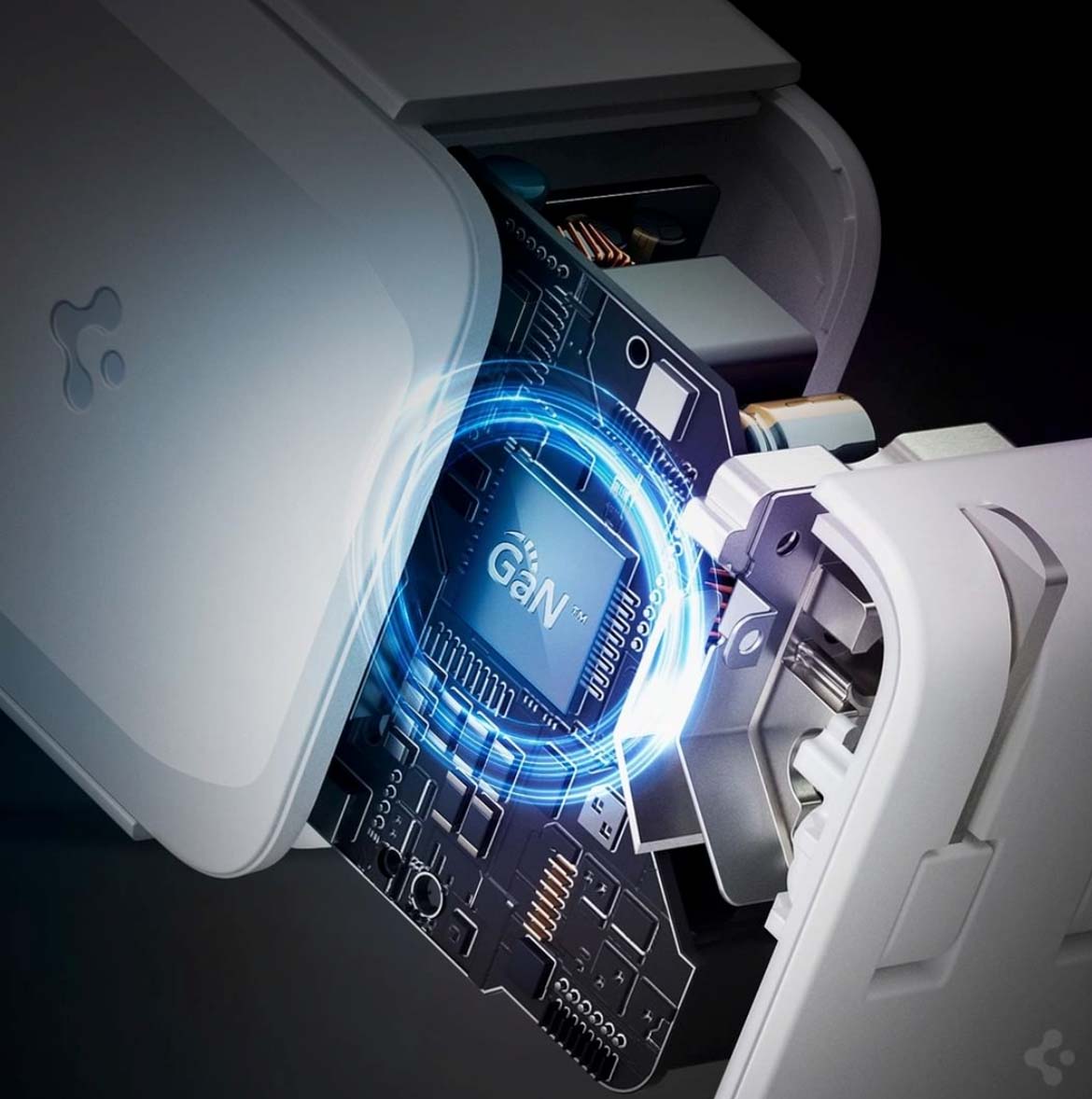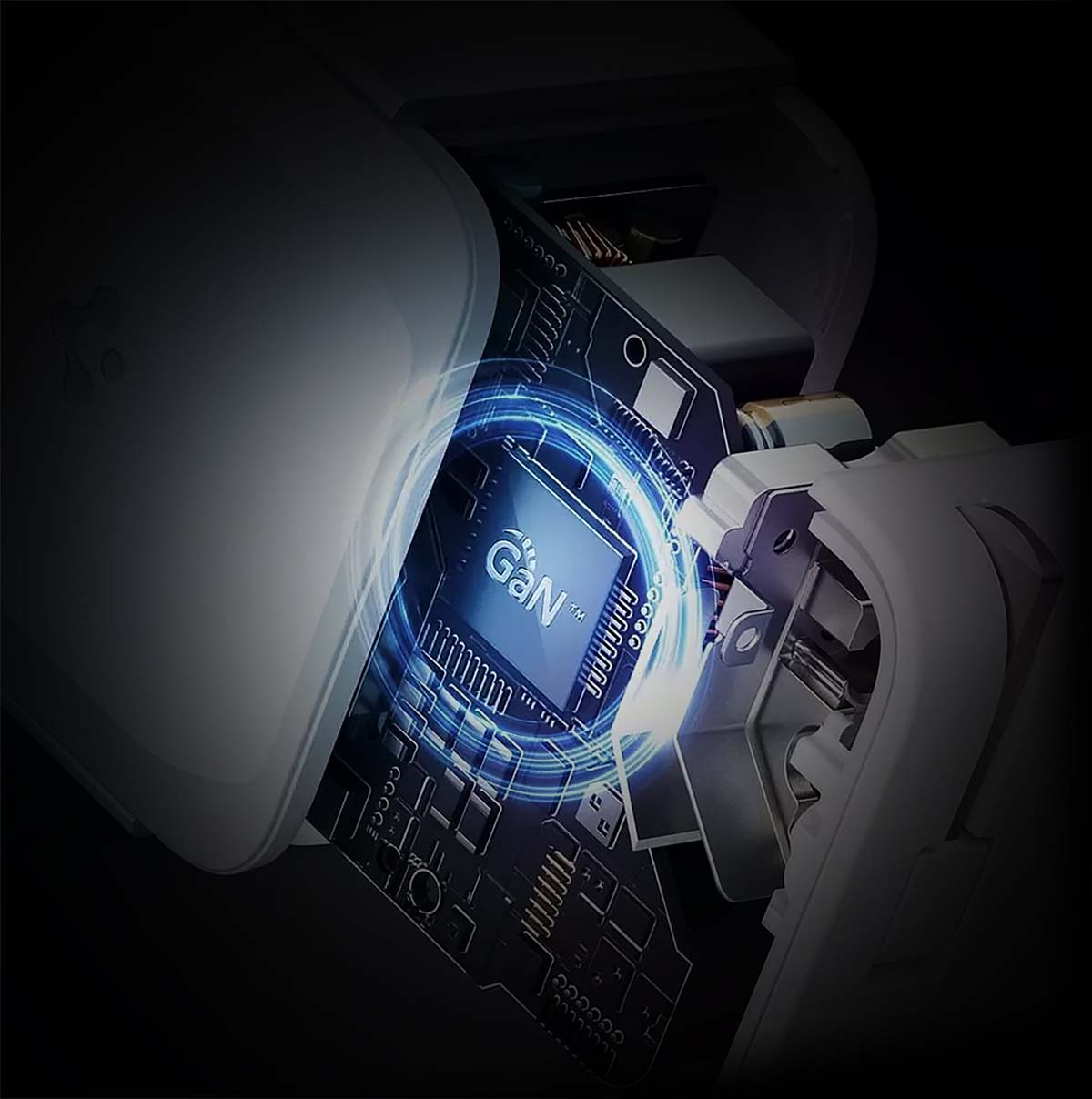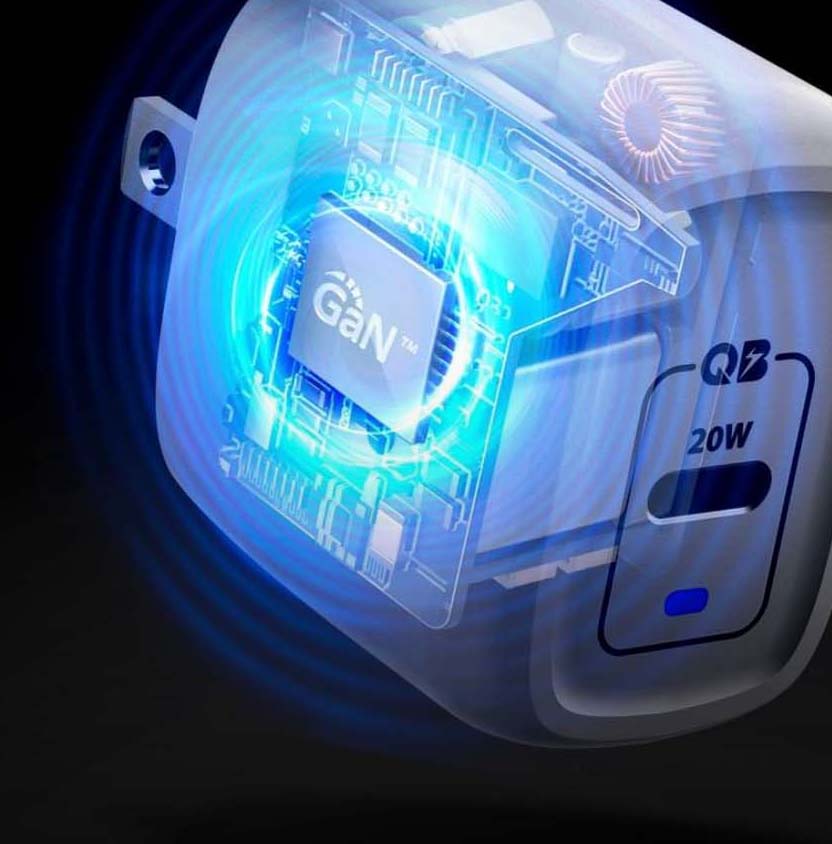
What is a  Charger?
Charger?
A GaNFast™️ Charger is a next-generation power adaptor built around Navitas’ GaNFast power ICs that speeds the charging of mobile devices including phones, laptops and tablets by delivering higher power to the device battery than a traditional silicon-based charger.
A few years ago, the silicon-based 5W ‘sugarcube’ would have been a typical charger. However, as this conventional technology can take over five hours to charge today’s power-hungry, large-screen smartphones there has been a growing demand for higher power wired and wireless ‘Fast Charger’ solutions that charge more quickly. GaNFast chargers are perfect for addressing this demand.
Many GaNFast chargers are now supplied as inbox Fast Chargers by a number of leading consumer electronic brands such as Lenovo, Dell, LG, Samsung, OPPO, vivo, Xiaomi. Others are supplied as aftermarket solutions by third-party accessory specialists.
What is a  Charger?
Charger?

A GaNFast™️ Charger is a next-generation power adaptor built around Navitas’ GaNFast power ICs that speeds the charging of mobile devices including phones, laptops and tablets by delivering higher power to the device battery than a traditional silicon-based charger.
A few years ago, the silicon-based 5W ‘sugarcube’ would have been a typical charger. However, as this conventional technology can take over five hours to charge today’s power-hungry, large-screen smartphones there has been a growing demand for higher power wired and wireless ‘Fast Charger’ solutions that charge more quickly. GaNFast chargers are perfect for addressing this demand.
Many GaNFast chargers are now supplied as inbox Fast Chargers by a number of leading consumer electronic brands such as Lenovo, Dell, LG, Samsung, OPPO, vivo, Xiaomi.Others are supplied as aftermarket solutions by third party accessory specialists.

Why is Gallium Nitride (GaN) Important for Fast Chargers?
For the companies that make Fast Chargers, a big challenge is delivering a form factor small enough and light enough for easy carrying but powerful enough for rapid charging. That’s why an ever-growing number of these companies are basing their adaptors on gallium nitride (GaN) semiconductors.
Delivering superior performance when compared with traditional silicon semiconductors, GaN has revolutionized fast charging for phones, tablets and laptops by supporting charging times that are 3x faster in products that are as little as half the size and weight of their predecessors.
This increased ‘power density’ not only allows GaN-based Fast Chargers to support higher output powers but provides opportunities to add multiple outputs for simultaneous charging of different devices without increasing product size.
Why is Gallium Nitride (GaN) Important for Fast Chargers?
For the companies that make Fast Chargers, a big challenge is delivering a form factor small enough and light enough for easy carrying but powerful enough for rapid charging. That’s why an ever-growing number of these companies are basing their adaptors on gallium nitride (GaN) semiconductors.
Delivering superior performance when compared with traditional silicon semiconductors, GaN has revolutionized fast charging for phones, tablets and laptops by supporting charging times that are 3x faster in products that are as little as half the size and weight of their predecessors.
This increased ‘power density’ not only allows GaN-based Fast Chargers to support higher output powers but provides opportunities to add multiple outputs for simultaneous charging of different devices without increasing product size.


Who Makes  Chargers?
Chargers?

All the top 10 mobile phone and laptop companies, including Dell, Lenovo, Samsung, vivo and OPPO, plus aftermarket suppliers such as Anker, Belkin, Baseus, Amazon,Ugreen,Spigen and many more are developing GaNFast chargers using Navitas technology.
Power ratings range from around 10W to as much as 300W and single-, dual-, triple- and multiple port output options are all available.
For more details on some of the companies delivering state-of-the-art fast charging adaptors click here.
Who makes  Chargers?
Chargers?

All the top 10 mobile phone and laptop companies, including Dell, Lenovo, Samsung, vivo and OPPO, plus aftermarket suppliers such as Anker, Belkin, Baseus, Amazon, Ugreen, Spigen and many more are developing GaNFast chargers using Navitas technology.
Power ratings range from around 10W to as much as 300W and single-, dual-, triple- and multiple port output options are all available.
For more details on some of the companies delivering state-of-the-art fast charging adaptors click here.

What is an Ultra-Fast GaN Charger?
Recent developments in charging and phone-battery technology have allowed some smartphone companies to achieve lightning-fast charging – for example from 0-100% in less than 10 minutes. The same 150W charger can quickly charge large laptops, and thanks to a ‘USB-PD’ protocol, can safely charge your 5W earbuds too, so you only need to carry one GaNFast charger
What is an Ultra-Fast GaN Charger?
Recent developments in charging and phone-battery technology have allowed some smartphone companies to achieve lightning-fast charging – for example from 0-100% in less than 10 minutes. The same 150W charger can quickly charge large laptops, and thanks to a ‘USB-PD’ protocol, can safely charge your 5W earbuds too, so you only need to carry one GaNFast charger


Why do I Need a  Charger?
Charger?
It is impossible to imagine a world in which we don’t have instant, 24-hour access to information, e-mail, messaging, social networks, rich media, gaming and a host of other data-intensive apps, functions, and services at our fingertips thanks to our mobile phones and portable devices.
Because these portable devices are almost ‘always-on’, there is a constant drain on the device battery. This is why for many of us, charging has become a frustrating inevitability. At the same time, as the performance of our electronic mobile devices continues to improve, in some cases the size also increases, so too does the power needed from the battery.
To maximize the time between charges, even as power demands grow, mobile device manufacturers seek to continually improve the technology of their batteries so as to deliver increased capacity. The downside is that larger battery capacities mean longer charge times, at least when using conventional chargers. This is fine if you can leave your device plugged in overnight or for long periods of time, but not so convenient if you are on the move and only have a short period of time where there is access to a wall plug in an airport, train station, coffee shop or meeting room.
These are some of the key reasons that most mobile phones now offer fast and ultra-fast charging speeds and why we are seeing the rapid expansion of the market for Fast Charger technologies
Why do I Need a  Charger?
Charger?

It is impossible to imagine a world in which we don’t have instant, 24-hour access to information, e-mail, messaging, social networks, rich media, gaming and a host of other data-intensive apps, functions, and services at our fingertips thanks to our mobile phones and portable devices.
Because these portable devices are almost ‘always-on’, there is a constant drain on the device battery. This is why for many of us, charging has become a frustrating inevitability. At the same time, as the performance of our electronic mobile devices continues to improve, in some cases the size also increases, so too does the power needed from the battery.
To maximize the time between charges, even as power demands grow, mobile device manufacturers seek to continually improve the technology of their batteries so as to deliver increased capacity. The downside is that larger battery capacities mean longer charge times, at least when using conventional chargers. This is fine if you can leave your device plugged in overnight or for long periods of time, but not so convenient if you are on the move and only have a short period of time where there is access to a wall plug in an airport, train station, coffee shop or meeting room.
These are some of the key reasons that most mobile phones now offer fast and ultra-fast charging speeds and why we are seeing the rapid expansion of the market for Fast Charger technologies.

When to Choose a Fast Charger
The need for a Fast Charger will depend on different factors and individual circumstances ranging from the type of mobile device and daily usage profile to the capacity of the device’s battery, whether you have enough time to rely on standard charging times and if you need to quickly charge multiple devices simultaneously.
Most chargers are designed for either Qualcomm’s proprietary Quick Charge (QC) technology or the USB Power Delivery (USB-PD) standard, so it is important to check charger compatibility with a particular device. It is also important to ensure that charging cables are matched with the appropriate standard.
And it may sound obvious, but when choosing a Fast Charger it is important to consider the power rating of the device or devices that you will are charging.
If you choose a charger with an output lower than the maximum capability of your device you may not obtain optimum charging times. There is no benefit in over-specifying your Fast Charger as, while it is unlikely to cause any damage to your device, it may mean that you end up paying for a capability that you cannot take advantage of.
Away from the charging tech itself other factors that you may wish to take into account range from size and weight to ease of use, ergonomics, aesthetics and design as well as any additional integrated functionality.
When to Choose a Fast Charger
The need for a Fast Charger will depend on different factors and individual circumstances ranging from the type of mobile device and daily usage profile to the capacity of the device’s battery, whether you have enough time to rely on standard charging times and if you need to quickly charge multiple devices simultaneously.
Most chargers are designed for either Qualcomm’s proprietary Quick Charge (QC) technology or the USB Power Delivery (USB-PD) standard, so it is important to check charger compatibility with a particular device. It is also important to ensure that charging cables are matched with the appropriate standard.
And it may sound obvious, but when choosing a Fast Charger it is important to consider the power rating of the device or devices that you will are charging.
If you choose a charger with an output lower than the maximum capability of your device you may not obtain optimum charging times. There is no benefit in over-specifying your Fast Charger as, while it is unlikely to cause any damage to your device, it may mean that you end up paying for a capability that you cannot take advantage of.
Away from the charging tech itself other factors that you may wish to take into account range from size and weight to ease of use, ergonomics, aesthetics and design as well as any additional integrated functionality.
